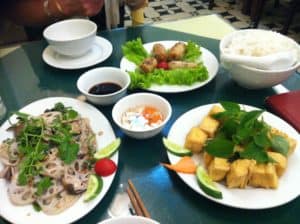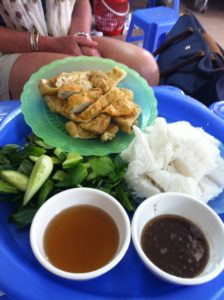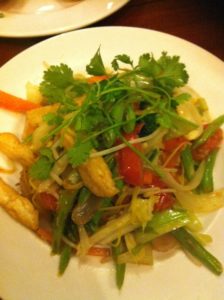Vietnam has some of the most exciting and varied cuisine in Southeast Asia, with stand-out specialities such as shrimp spring rolls, sticky rice and pork belly rolls and the infamous beef noodle soup (pho). That’s all well and good, but what about the non-meat eaters among us? I have been a vegetarian since the age of 11, and having lived and travelled in Asia a fair bit, I’ve managed to pick up tricks of the trade and essential dietary staples that make eating out as a veggie in Southeast Asia a little easier.
1. Ask your guide to write down a few key phrases in the local language
If you are like my mum and I, you will like eating where the locals do; authentic restaurants, small plastic chairs on street corners and mobile carts with freshly cooked delicacies. The down side of eating local is that sometimes the waiters don’t speak English. In fact, in my experience there is a direct correlation between how authentic the restaurant is and how little English is spoken amongst the staff, i.e. you know you are in a place with genuine Vietnamese cuisine when you can’t even communicate that you’d like to see a menu.
That’s where your guide can be invaluable. Ask him or her to write down “I am a vegetarian”, “I am a vegan”, “no fish sauce please” or “what tofu dishes can you recommend?” for you in Vietnamese. That way, when you find your dining spot for the evening, you can simply show the waiter your notepad and not only will they be thoroughly amused, but they will also understand the basics of what you can and cannot eat. From that, they will be able to point you in the right direction on the menu, or even better simply leave it up to them and their expertise to prepare some of the best options for you within your dietary requirements.
2. Avoid fish sauce
Fish sauce is served with almost everything in Vietnam, from spring rolls to crispy egg pancake to vermicelli noodles. Luckily for us veggies, it is often served on the side in a small dish so is usually quite easy to avoid. However, it’s always worth checking that they don’t use it to cook with, and be careful not to confuse it for sweet chilli sauce which is also served now and then as a side-dip.
3. Monastery munch
Somewhere between 9%-16% of Vietnamese people follow the religion of Buddhism, which emphasises the importance of a vegan diet. Many monasteries across Vietnam have restaurants attached to them that not only cater for Buddhist monks, but also for all vegetarians. Not only do these eateries offer classic dishes like noodles, spring rolls and stir-fried vegetables, but also create “fake meat” dishes using bean curd, such as vegetarian chicken, fish and beef. The Buddhist monks’ creative use of bean curd in this way allows us veggies to try some traditional Vietnamese dishes that would normally be unavailable to us due to meat content. Chat to your travel consultant about including local monastery restaurants in your itinerary and head on down for a unique dining experience.
4. For decoration only – don’t touch the lettuce!
This rule of thumb is applicable not only to vegetarians and vegans, but pretty much everyone. The Vietnamese are well known for their exquisite presentation when it comes to food, with most dishes being served on a decorative bed of lettuce with ornately carved carrots and tomatoes in the shape of lotus flowers. I once made the mistake of eating the decorative salad that accompanied a meat dish that my fellow diners had ordered, mainly because I was totally starving and simply couldn’t wait for my vegetarian dish to arrive. Big mistake. Whilst food hygiene standards are generally acceptable in Vietnam (with a sensible level of personal caution taken into account), these side salads are generally not washed and are purely to make the dish look pretty. Take my advice, after a few days feeling VERY poorly, to not eat these beautiful-looking bits of salad. I’ve learned the hard way that they are indeed for decoration, and not for consumption.
5. Try the tofu.
Yes, its slimy. Yes, its wobbly. Yes, it tastes bland on its own and un-cooked. Many international cuisines have failed to successfully incorporate tofu into their go-to ingredients, however trust me when I say that the Vietnamese have got cooking with bean curd down to an art. Usually deep fried, delicious tofu that is crispy on the outside and silky on the inside can be found scattered on top of papaya salads, floating in delicious noodle soup, stir-fried with rice noodles or simply served on its own with a selection of dipping sauces. Make sure to try the “fake meat” that is skilfully created from tofu (mentioned above in the Monastery Munch section); you can order vegetarian chicken with ginger and spring onion, or vegetarian beef with onions and pepper sauce to name a few.
To discuss your holiday experience in Vietnam, fill in this enquiry form here. If you’d like to speak to Lucy herself, please feel free to specify! Ideas for a holiday in Vietnam can be found here.




